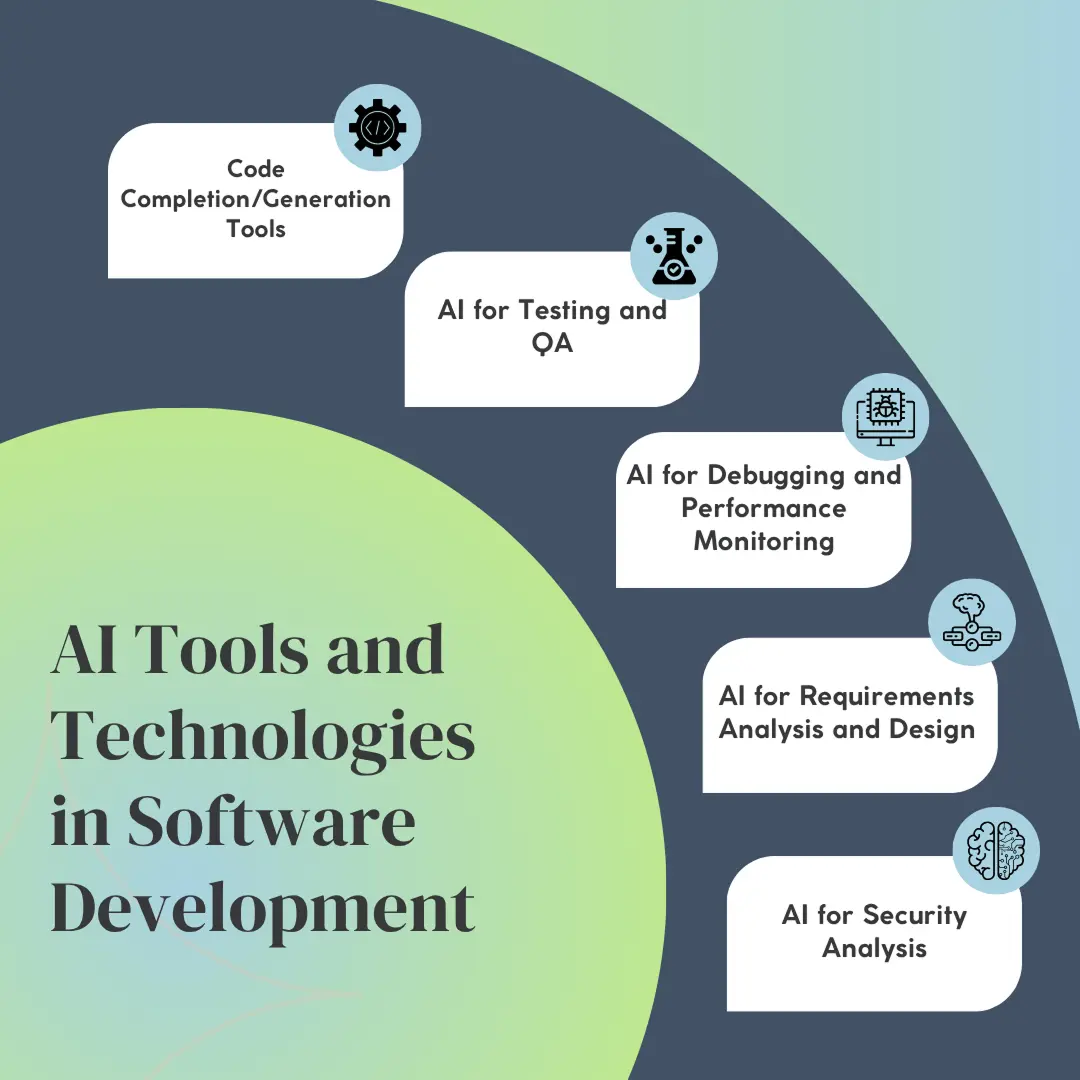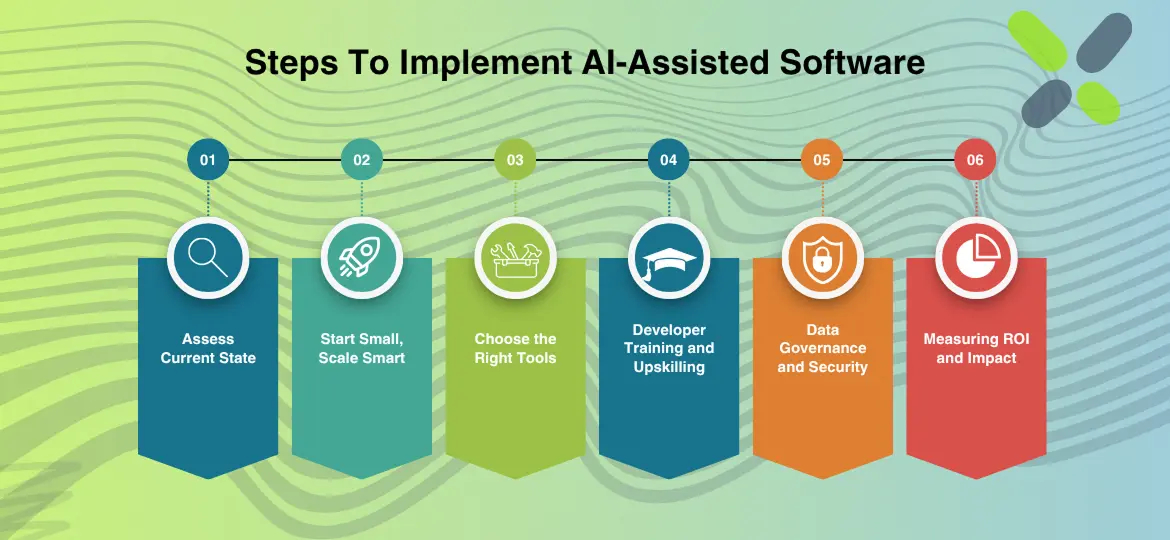Current software development practices are driven by an ever-increasing need for sophisticated apps delivered at astonishing speed. Enterprises aim to meet rapidly shifting customer expectations while successfully competing in increasingly volatile markets; software systems become ever more intricate due to increased complexity in regard to architectures, integrations and functionalities that extend far beyond initial expectations; traditional development methodologies are thus being stretched thin as time for delivery decreases significantly.
Artificial Intelligence has emerged as a transformational solution, promising to revolutionize all facets of software development lifecycle management and support efficient teams’ abilities to efficiently meet efficiency and quality objectives. Therefore, this introduction to AI software development strategies covers AI assisted tools as well as strategies.
What is AI-Assisted Software Development?
AI-assisted software development refers to the strategic implementation of Artificial Intelligence (AI) tools and techniques throughout all stages of the Software Development Lifecycle (SDLC). Rather than simple automation involving predetermined rules executing repetitive tasks, intelligent assistance provides an additional cognitive enhancement for software creation projects.
AI-assisted development tools are designed to draw insights from vast databases of code, project histories and best practices by learning from vast datasets of code, project histories and best practices; providing context-aware suggestions or even creating entirely new code or test cases as necessary. Their aim is to empower human developers by offloading tedious or highly analytical tasks thereby increasing productivity while improving output quality while freeing them up for higher level tasks such as creative design or strategic decision-making rather than routine nit-picking tasks.
Why Modern Enterprises Need This Guide
Businesses operating within modern technology face immense pressure to innovate continuously, produce top-quality products, and stay ahead of competitors by remaining ahead. This guide is essential to modern enterprises as it details strategies to develop AI software to navigate this challenging environment. By adopting AI technologies into software development processes, organizations can increase operational efficiencies and product quality while building an innovation culture critical for long-term success. Rapid software development, testing, and deployment while at the same time minimizing errors and optimizing resource allocation is no longer considered a luxury in today’s ever-evolving digital economy. Instead, it has become essential.
Key AI Tools and Technologies in Software Development

AI in software development has seen unprecedented adoption over recent years due to an explosion of cutting-edge tools and technologies designed to incorporate it seamlessly into existing workflows and provide immense benefits by automating, augmenting, or speeding various stages of SDLC. At its heart lies generative AI in software development, which has revolutionized how code is created and managed.
Code Completion/Generation Tools
AI’s impact on programming can best be witnessed with advanced code completion and generation tools. These tools, powered by large language models (LLMs) like GitHub Copilot, Amazon CodeWhisperer, and Google Gemini Code Assist, can use existing code repositories to predict and recommend future lines, functions or even entire blocks of code that need writing. AI software development solutions dramatically boost developer productivity by eliminating repetitive manual work such as boilerplate coding. AI makes an immediate, impactful statement about its benefits in software development; developers can focus on complex logic rather than syntax or common patterns – in short, AI is fundamentally revolutionizing developer experiences across industries and environments.
AI for Testing and QA
Artificial intelligence has revolutionized the time-consuming and often error-prone processes of testing and quality assurance, significantly speeding up execution speeds while increasing test coverage while decreasing execution times and defect detection timeframes, leading to greater software quality with reduced manual effort required from developers.
AI tools now create comprehensive test cases automatically while also identifying edge cases human testers may miss. In turn, this leads to faster execution speeds as well as earlier defect identification, which ultimately contributes to more comprehensive coverage with faster test execution speeds, making results in more extensive coverage. These AI strategies empower organizations to achieve robust software development strategies using significantly less manual effort than would usually be required from human development strategies alone.
AI for Debugging and Performance Monitoring
Debugging and performance monitoring are critical but time-consuming components of software development. AI tools have revolutionized these areas by rapidly and accurately pinpointing errors with remarkable speed and accuracy, using analysis on code, execution paths, system logs or performance bottlenecks proactively as part of debugging cycles for quicker problem resolution or optimized application performance – one of many significant advantages AI brings.
These features contribute significantly towards shortening debugging cycles as a whole, which yields faster problem resolution with optimized application performance – an undisputed hallmark benefit of AI in software development.
AI for Requirements Analysis and Design
Artificial intelligence can bring significant advantages to software requirements analysis and design processes. AI tools are capable of quickly scanning large amounts of natural language text found within user stories, feedback reports, documentations or feedback forms in order to detect inconsistencies or implicit requirements that need further elucidating; some even go as far as helping generate initial design prototypes wireframes or database schemas based solely on text descriptions! This improves clarity and completeness while meeting stakeholder needs at every point in development processes, thus providing a strong foundation for successful software strategies using AI strategies.
AI for Security Analysis
As cyber threats increase, artificial intelligence in software development plays a pivotal role in protecting application security. AI-powered tools can perform static and dynamic code analyses that help identify vulnerabilities, suggest secure coding practices, predict potential exploits, leverage machine learning models for automated security analysis, integrate into continuous integration/continuous delivery pipelines for constant monitoring purposes and prioritize key issues – providing enterprises with a proactive security analysis solution and helping build more secure apps from scratch. This proactive security analysis enabled by AI is the key advantage that AI offers organizations by assisting enterprises to develop more resilient applications from the ground up.
Implementing AI-Assisted Software Development: A Strategic Roadmap

Starting your journey towards AI-assisted software development requires creating a strategic roadmap, not simply selecting random tool adoptions. A structured approach ensures enterprises can integrate AI effectively into existing workflows and maximize its benefits in software development for sustained competitive advantages. This roadmap details key steps necessary for its successful implementation while emphasizing actionable AI software development strategies.
Assess Current State
To ensure a successful AI implementation, an initial step requires conducting a comprehensive review of your existing software development landscape. This should focus on identifying any existing pain points, inefficiencies or areas in which AI could make the most significant difference to productivity and development teams’ skill sets. Assess existing tools, processes and the skill sets of teams within your development departments as you examine current tools used, methods used and skill sets of individuals within them as you identify any slow delivery cycles, persistent bug issues, or code consistency difficulties which you are currently facing when working within development teams as this step allows identifying AI’s most impactful applications while setting clear objectives and measuring eventual return on Investment (ROI). This baseline assessment step ensures clarity when setting clear goals, as it helps define objectives while measuring return on Investment Return on Investment (ROI).
Start Small, Scale Smart
A gradual approach is strongly advised rather than embarking on an enterprise-wide transformation from day one. Start small with pilot projects focused on specific use cases where AI can demonstrate immediate, tangible value. Introduce an AI-powered code completion tool for one team; automate part of your testing procedure, or experiment with generation AI for document generation in software development. Acknowledging these initial successes and obstacles enables iterative refinement of AI software development strategies before scaling them across more teams or more complex workflows. Adopting this “start small, scale smart” strategy minimizes risks while building internal trust among your staff members.
Choose the Right Tools
The market for AI-assisted development tools is rapidly expanding, offering AI-assisted development tools that have quickly proliferated on the market in recent years, providing solutions for every stage of the software development lifecycle (SDLC). When choosing AI tools that assist software development for you specifically, consider their compatibility with existing tech stack, features (code generation, testing, security analysis or debugging, etc.), ease of integration and vendor support as key criteria in selecting suitable tools that match up best with identified pain points or strategic objectives of software development projects.
These should all provide impactful AI advantages tailored for your unique circumstances. When searching out AI-assisted tools, they must align perfectly with both identified areas and strategic objectives as they bring in benefits of AI in software development that bring significant impactful AI advantages into software development projects.
Developer Training and Upskilling
The success of AI-assisted development relies on your development teams being prepared. AI tools should only ever augment human developers, not replace them; therefore, investing in comprehensive training and upskilling programs for your development teams is vital to its success. Such training must cover not only using new AI-assisted development tools efficiently but also understanding and interpreting AI outputs, providing prompts that aid learning processes effectively, collaborating synergistically with AI.
As well as creating an environment in which continuous learning exists alongside seeing AI as an asset leading to higher productivity and job satisfaction among your developers ensuring the most out of AI’s full potential is realized resulting in higher productivity and job satisfaction overall – ultimately contributing towards increased productivity and job satisfaction levels and productivity gains.
Data Governance and Security
AI models utilizing Gen AI software development depend heavily on data. Establishing robust data governance frameworks is vital to safeguard its quality, integrity, privacy, and security when training or operating AI systems. This involves setting clear policies around data collection, storage, usage access permission usage as well as complying with relevant regulations (i.e. GDPR/CCPA compliance) while protecting proprietary code or sensitive information from potential vulnerabilities introduced by AI tools/models – proactive data governance/security measures build trust while mitigating risks related to adopting AI technologies and models etc.
Measuring ROI and Impact
To justify investments in AI technology and ensure continuous improvements, it’s crucial to set clear metrics to measure both the return on investment (ROI) and the overall impact of your AI projects. Not only can cost savings be realized through software engineering improvements, but other tangible metrics may include reduced development times and post-release bug detection rates, improved code quality scores, quicker time-to-market for new features and increased developer satisfaction as well. Qualitative metrics such as increased innovation capacity and enhanced risk management should also be carefully taken into account when looking to implement AI software development strategies. Regular tracking and reporting on these metrics will highlight their tangible advantages while shaping future AI software development strategies.
Conclusion
The transformative power of AI in software development cannot be overstated. We have witnessed its revolutionary effect first-hand – from code generation and testing, advanced debugging and security analysis all the way up to generational AI, making development faster, more efficient and with greater quality than ever before. Modern enterprises need AI strategically in their business strategy; it’s no longer optional if they wish to remain competitive, maximize efficiency, enhance product quality and drive continuous innovation in an ever-evolving tech environment. AI won’t replace human ingenuity entirely; instead, it should act as an indispensable partner that facilitates collaboration between human intelligence and artificial intelligence – this allows developers to focus more on creative problem-solving while AI handles data-intensive analytics tasks that would otherwise take too much of their time and focus.
Are you ready to unlock AI-assisted software development potential in your enterprise? At Echoinnovate IT, we specialize in leading businesses through this transformative journey of AI software development. Our experienced engineers and AI specialists offer complete AI software development strategies ranging from initial assessment and tool selection through integration and ongoing support – helping streamline operations while improving user experiences and speeding time-to-market.
Give Echoinnovate IT a call now for a complimentary consultation to see how AI solutions can fast-track digital success!
AI-Assisted Software Development: A Strategic Guide for Modern Enterprises
What is AI-assisted software development?
AI-assisted software development refers to the use of artificial intelligence tools and techniques—such as machine learning models, natural language processing, and code generation algorithms—to support, accelerate, and optimize various phases of software development. This includes code writing, testing, bug detection, project management, and more.
How can AI benefit enterprise software development?
AI brings numerous benefits to enterprise software development, including faster time to market, improved code quality, reduced bugs, automated testing, enhanced team productivity, and better decision-making through predictive analytics.
Which AI tools are commonly used in software development today?
Common AI tools include GitHub Copilot, Amazon CodeWhisperer, Tabnine, DeepCode, and ChatGPT. These tools assist with code completion, documentation, refactoring, and more.



